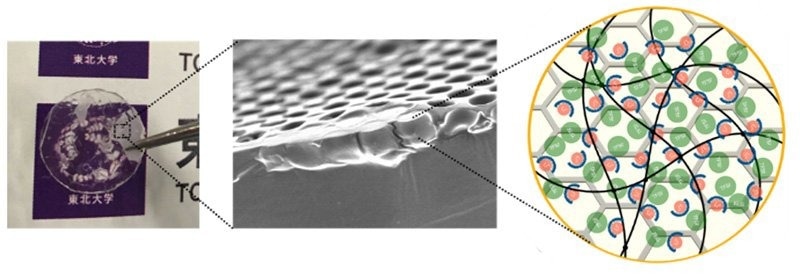Reviewed by Mila PereraSep 8 2022
Li-ion batteries (LIBs) are frequently used in commercial batteries for EVs and smartphones. LIBs are continually charged and discharged by lithium ions (Li-ion) traveling to and fro between the positive and negative electrodes, with the Li-ion electrolyte serving as a corridor for the ions.
 A photograph (left), scanning electron microscope image (center), and schematic illustration of composite electrolyte structure (right), respectively. Image Credit: ©Grewal and Yabu.
A photograph (left), scanning electron microscope image (center), and schematic illustration of composite electrolyte structure (right), respectively. Image Credit: ©Grewal and Yabu.
Organic electrolytes, e.g., liquid ethylene carbonate (EC) and their gels, have generally been employed as the Li-ion electrolyte due to their ionic conductivity and voltage resistance. However, as gels and liquids are combustible, a shift to safer polymeric solid electrolytes is desirable.
Polymeric solid electrolytes, for example, polyethylene glycol (PEG), have been recommended as impact-resistant Li-ion electrolytes. However, PEG-based polymer electrolytes tend to crystallize near room temperature, causing a substantial decrease in Li-ion conductivity to about 10-6 seconds/cm.
To resolve this issue, the research team has designed a novel type of polymeric solid electrolyte by integrating a porous polymer membrane with numerous micron pores and a photo-cross-linkable polyethylene glycol PEG-based polymer electrolyte.
The polymeric solid electrolyte achieved a broad potential window (4.7 V), a high Li-ion transference number (0.39), and a high Li-ion conductivity in the 10-4 seconds/cm group, which is equal to a liquid and adequate for real-world use.
Li-ions shifting in the electrolyte move in different directions due to natural diffusion. The distance is many µm to 10 µm and does not move linearly at all times between electrodes, which is one of the causes of falling ionic conductivity.
In the current study, the working of photo-cross-linked PEG-based solid polymer electrolytes was therefore enhanced by combining them with micron-sized porous membranes.
This polymeric solid electrolyte demonstrates high performance as an electrolyte and its effectiveness in preventing the development of Li dendrites (dendritic crystals), which can result in ignition due to the addition of a porous membrane. The realization of safe, high-performance LIBs will aid the creation of a sustainable energy supply, which is the seventh objective of the SDGs.
Journal Reference:
Grewal, M. S., et al. (2022) Increasing the ionic conductivity and lithium-ion transport of photo-cross-linked polymer with hexagonal arranged porous film hybrids. iSciences. doi.org/10.1016/j.isci.2022.104910.